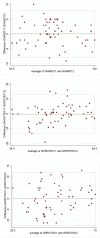Evaluation of the inter and intraobserver reproducibility of the GRASP method: a goniometric method to measure the isolated glenohumeral range of motion in the shoulder joint
- PMID: 33993351
- PMCID: PMC8124032
- DOI: 10.1186/s40634-021-00352-z
Evaluation of the inter and intraobserver reproducibility of the GRASP method: a goniometric method to measure the isolated glenohumeral range of motion in the shoulder joint
Abstract
Purpose: To evaluate the intra and interobserver reproducibility of a new goniometric method for evaluating the isolated passive range of motion of the glenohumeral joint in an outpatient setting.
Methods: This is a prospective observational study on healthy subjects. The Glenohumeral ROM Assessment with Scapular Pinch (GRASP) method is a new method for assessing the isolated range of motion (ROM) of the glenohumeral joint (GH) by a single examiner with a clinical goniometer. It measures the isolated glenohumeral passive abduction (GH-AB), passive external rotation (GH-ER) and internal rotation (GH-IR) with the arm at 45º of abduction. These three GH ROM parameters were measured in both shoulders of 30 healthy volunteers (15 males/15 females, mean age:41.6[SD = 10.3] years). The full shoulder passive abduction, passive external rotation and internal rotation 45º of abduction were measured by the same examiners with a goniometer for comparison. One examiner made two evaluations and a second examiner made a third one. The primary outcome was the intra- and interobserver reproducibility of the measurements assessed with intraclass correlation coefficients (ICC) and the Bland-Altman plot.
Results: The intra-observer ICC for isolated glenohumeral ROM were: 0.84 ± 0.07 for GH-ABD, 0.63 ± 0.09 for GH-ER, and 0.61 ± 0.14 for GH-IR. The inter-observer ICC for isolated glenohumeral ROM were: 0.86 ± 0.06 for GH-ABD, 0.68 ± 0.12 for GH-ER, and 0.62 ± 0.14 for GH-IR. These results were similar to those obtained for full shoulder ROM assessment with a goniometer.
Conclusion: The GRASP method is reproducible for quick assessment of isolated glenohumeral ROM.
Level of evidence: III.
Keywords: Glenohumeral joint; Goniometric; Range of motion; Shoulder.
Conflict of interest statement
The authors declare they have no competing interests.
Figures


Similar articles
-
Assessment of isolated glenohumeral range of motion in patients with adhesive capsulitis can help predict failure of conservative treatment: a pilot study.Knee Surg Sports Traumatol Arthrosc. 2022 Jun;30(6):2099-2104. doi: 10.1007/s00167-021-06804-4. Epub 2021 Nov 26. Knee Surg Sports Traumatol Arthrosc. 2022. PMID: 34825917
-
Influence of humeral abduction angle on axial rotation and contact area at the glenohumeral joint.J Shoulder Elbow Surg. 2019 Mar;28(3):570-577. doi: 10.1016/j.jse.2018.08.023. Epub 2018 Dec 17. J Shoulder Elbow Surg. 2019. PMID: 30573432
-
Reliability of a New Clinical Instrument for Measuring Internal and External Glenohumeral Rotation.Sports Health. 2015 Jul;7(4):312-7. doi: 10.1177/1941738113512094. Sports Health. 2015. PMID: 26137176 Free PMC article.
-
Pitch Volume and Glenohumeral and Hip Motion and Strength in Youth Baseball Pitchers.J Athl Train. 2018 Jan;53(1):60-65. doi: 10.4085/1062-6050-323-16. Epub 2017 Dec 28. J Athl Train. 2018. PMID: 29283678 Free PMC article.
-
Clinical measurements for inferior, posterior, and superior glenohumeral joint contracture evaluation in children with brachial plexus birth palsy: intraobserver and interobserver reliability.J Shoulder Elbow Surg. 2018 Oct;27(10):1779-1784. doi: 10.1016/j.jse.2018.04.014. Epub 2018 May 30. J Shoulder Elbow Surg. 2018. PMID: 29859662
Cited by
-
Comparison of Machine Learning Algorithms and Hybrid Computational Intelligence Algorithms for Rehabilitation Classification and Prognosis in Reverse Total Shoulder Arthroplasty.Bioengineering (Basel). 2025 Feb 5;12(2):150. doi: 10.3390/bioengineering12020150. Bioengineering (Basel). 2025. PMID: 40001670 Free PMC article.
-
Efficacy of Conservative Therapy in Overhead Athletes with Glenohumeral Internal Rotation Deficit: A Systematic Review and Meta-Analysis.J Clin Med. 2022 Dec 20;12(1):4. doi: 10.3390/jcm12010004. J Clin Med. 2022. PMID: 36614805 Free PMC article. Review.
-
Assessment of isolated glenohumeral range of motion in patients with adhesive capsulitis can help predict failure of conservative treatment: a pilot study.Knee Surg Sports Traumatol Arthrosc. 2022 Jun;30(6):2099-2104. doi: 10.1007/s00167-021-06804-4. Epub 2021 Nov 26. Knee Surg Sports Traumatol Arthrosc. 2022. PMID: 34825917
-
Feasibility and preliminary efficacy of heavy Lifting Strength Training versus Usual Care in Head and Neck Cancer Survivors (the LIFTING 2 Trial): A study protocol for a single-centre, phase II, randomized controlled trial.PLoS One. 2025 Jul 10;20(7):e0326860. doi: 10.1371/journal.pone.0326860. eCollection 2025. PLoS One. 2025. PMID: 40638621 Free PMC article.
-
Virtual embodiment for improving range of motion in patients with movement-related shoulder pain: an experimental study.J Orthop Surg Res. 2023 Sep 26;18(1):729. doi: 10.1186/s13018-023-04158-w. J Orthop Surg Res. 2023. PMID: 37752613 Free PMC article.
References
-
- Beitzel K, Mazzocca AD, Bak K, Itoi E, Kibler WB, Mirzayan R, Imhoff AB, Calvo E, Arce G, Shea K. ISAKOS upper extremity committee consensus statement on the need for diversification of the Rockwood classification for acromioclavicular joint injuries. Arthroscopy. 2014;30(2):271–278. doi: 10.1016/j.arthro.2013.11.005. - DOI - PubMed
LinkOut - more resources
Full Text Sources
Other Literature Sources
Research Materials

